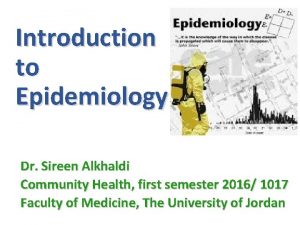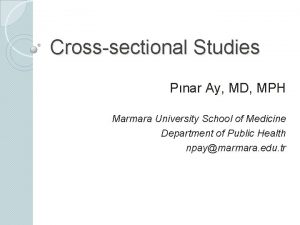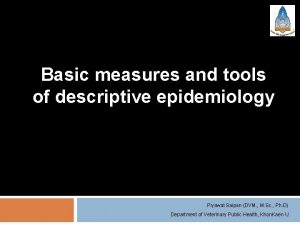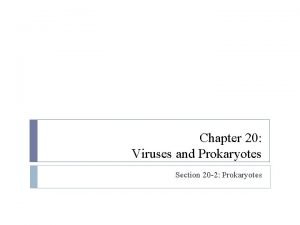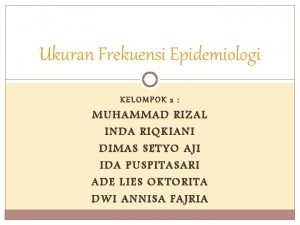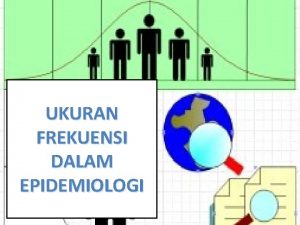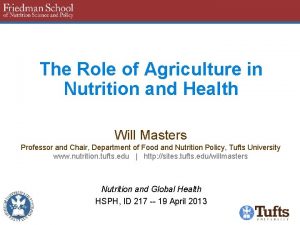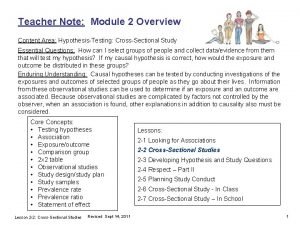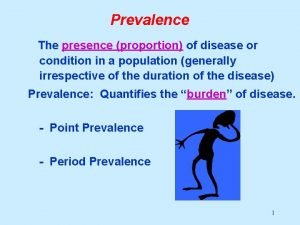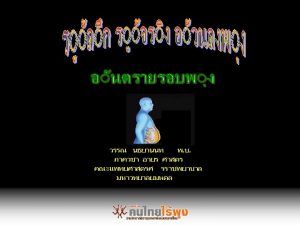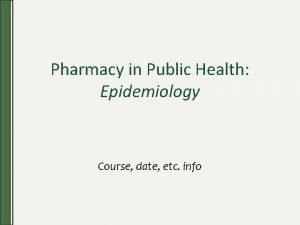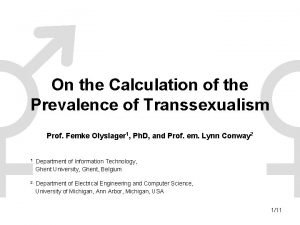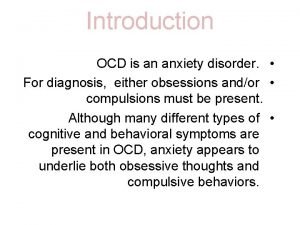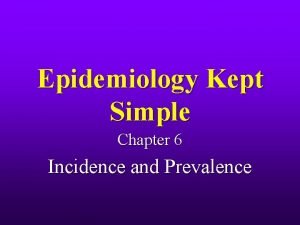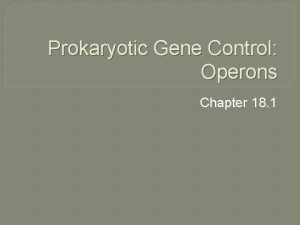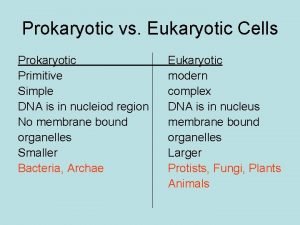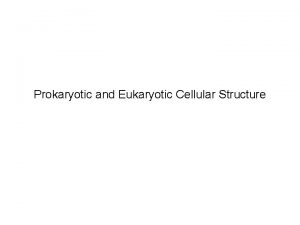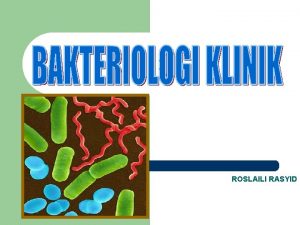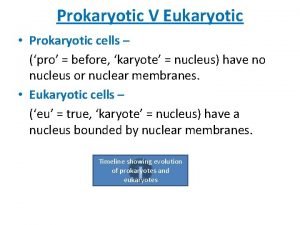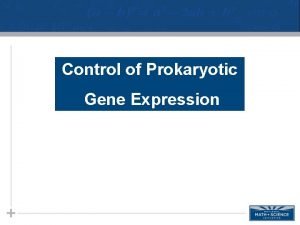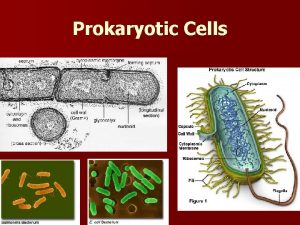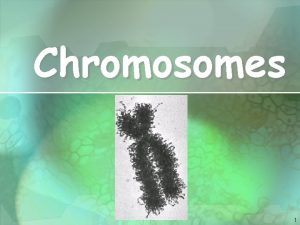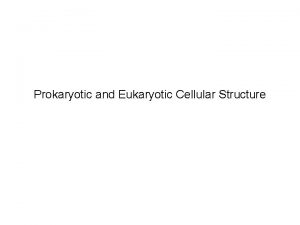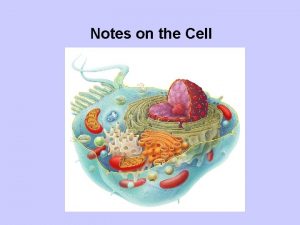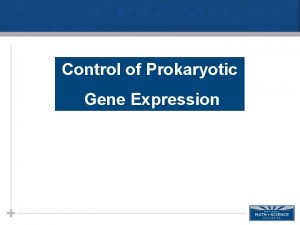Prokaryotes Chapter 27 Outline Prevalence of Prokaryotes Prokaryotic























- Slides: 23

Prokaryotes Chapter 27

Outline • • Prevalence of Prokaryotes Prokaryotic Diversity Prokaryotic Complexity Prokaryotic Variation Prokaryotic Metabolism Human Bacterial Diseases Benefits of Prokaryotes 2 2

Prevalence of Prokaryotes • Prokaryotes are the oldest, structurally simplest, and most abundant forms of life on earth. – abundant for over 2 billion years before the appearance of eukaryotes – 5, 000 different kinds currently recognized 3 3

Prokaryotic Cell 4 4

Prevalence of Prokaryotes • • Prokaryotic form – bacillus (bacilli) straight and rod-shaped – coccus (cocci) spherical shaped – spirillum (spirilla) long and helical shaped Some bacterial colonies form spore producing structures. 5 5

Prevalence of Prokaryotes • Prokaryotes versus Eukaryotes – unicellularity – cell size – chromosomes – cell division and recombination – internal compartmentalization – flagella – metabolic diversity 6 6

Prokaryotic Diversity • Key classification characteristics – photosynthetic or nonphotosynthetic – motile or nonmotile – unicellular or colony-forming or filamentous – spore formation by division or transverse binary fission 7 7

Kinds of Prokaryotes • Very early, prokaryotes split into two lines – Archaea and bacteria are as different in structure and metabolism from each other as either is from eukarya. § Domain Archaea 8 8

Prokaryotic Diversity • Comparing archaebacteria and bacteria – plasma membranes § composed of different lipids – cell wall § archaebacteria lack peptidoglycan – gene translation machinery § archaebacteria similar to eukaryotes – gene architecture § bacteria not interrupted by introns 9 9

Prokaryotic Complexity • Prokaryotic cell surface – cell wall maintains shape and protects the cell from swelling and rupturing § usually consist of peptidoglycan v Gram-positive - thicker peptidoglycan v Gram-negative - thinner peptidoglycan – flagella – slender protein - locomotion – pili - hairlike structures - attachment – endospores - resistant to environment 10 10

Gram Stain 11 11

Flagellar Motor 12 12

The Cell Interior • • • Internal membranes – invaginated plasma membrane Nucleoid region – lack nucleus - genes encoded with single double-stranded DNA Ribosomes – Prokaryotic ribosomes are smaller than eukaryotic ribosomes, and differ in protein and RNA content. 13 13

Prokaryotic Variation • Two process create bacterial variation: – mutation § spontaneous errors in DNA replication v prokaryotic ability to mutate rapidly often has adverse effect on humans – genetic recombination § occurs by gene transfer from one cell to another by viruses or conjugation 14 14

Prokaryotic Metabolism • • Autotrophs – obtain carbon from inorganic CO 2 § photoautotrophs - sunlight § chemoautotrophs - inorganic chemicals Heterotrophs – obtain carbon from organic molecules § photoheterotrophs - sunlight § chemoheterotrophs - organic molecules 15 15

Prokaryotic Metabolism • How heterotrophs infect host organisms – proteins secreted by type III system § may be used to transfer other virulence proteins into nearby eukaryotic cells 16 16

Human Bacterial Diseases • • Tuberculosis – afflicts respiratory system and easily transmitted from person to person through the air Dental caries – tooth decay caused by bacteria present in plaque § high sugar diets increase tooth decay v lactic acid bacteria ferment sugars and reduce p. H, thus degenerating tooth enamel 17 17

Human Bacterial Diseases • Sexually transmitted diseases – Gonorrhea (Neisseria gonorrhoeae) – Syphilis (Treponema pallidum) – Chlamydia (Chlamydia trachomatis) 18 18

Benefits of Prokaryotes • • Environment – chemical cycling – decomposition – nitrogen fixation § reduces N 2 to NH 3 Symbiotic properties – nitrogen-fixation – digestive tract of animals 19 19

Benefits of Prokaryotes • • Genetic engineering – nonpolluting insect control – bioremediation § pollutant removal – biofactories § commercial production of antibiotics Bioweapons – anthrax – smallpox 20 20

Bioremediation 21 21

Summary • • Prevalence of Prokaryotes Prokaryotic Diversity Prokaryotic Complexity Prokaryotic Variation Prokaryotic Metabolism Human Bacterial Diseases Benefits of Prokaryotes 22 22

23 23
 Period prevalence vs point prevalence
Period prevalence vs point prevalence Defination of prevalence
Defination of prevalence Period prevalence vs point prevalence
Period prevalence vs point prevalence Period prevalence vs point prevalence
Period prevalence vs point prevalence Chapter 20 viruses and prokaryotes
Chapter 20 viruses and prokaryotes Chapter 20 viruses and prokaryotes
Chapter 20 viruses and prokaryotes The quote sandwich example
The quote sandwich example Rumus point prevalence rate
Rumus point prevalence rate Morbiditas adalah
Morbiditas adalah Obesity prevalence europe
Obesity prevalence europe Prevalence ratio
Prevalence ratio Prevalence definition epidemiology
Prevalence definition epidemiology Prevalence of obesity
Prevalence of obesity Prevalence rate formula
Prevalence rate formula Prevalence calculation
Prevalence calculation Prevented fraction
Prevented fraction Ego-dystonic
Ego-dystonic Point and period prevalence
Point and period prevalence Incidence vs incidence rate
Incidence vs incidence rate Prevalence of schizophrenia
Prevalence of schizophrenia Prevalence ratio
Prevalence ratio Descriptive vs analytical epidemiology
Descriptive vs analytical epidemiology Calculate prevalence rate
Calculate prevalence rate Ocd behaviors
Ocd behaviors
